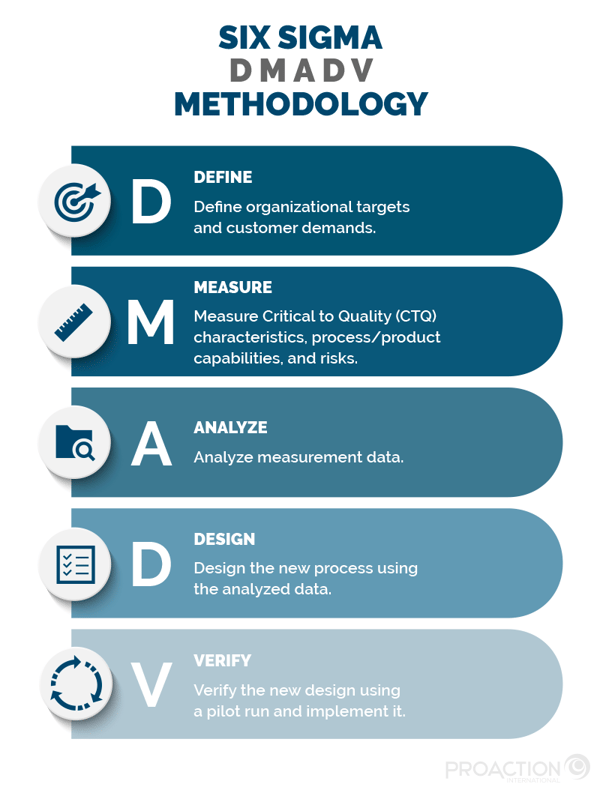What is Six Sigma?
The Six Sigma process originated in the field of quality control statistics. It is based on a statistical analysis approach focusing on data at a granular level to detect any error in business processes.
In statistics, the lower-case Greek letter sigma (σ) refers to the standard deviation from the mean value. The concept of sigma would therefore mean that there would be errors to eliminate at any point of deviation. In the 1920s, Walter Shewhart followed this concept and introduced a methodology of three sigma deviations from the mean to improve Lean Manufacturing processes.
Six Sigma is derived from the statistical bell curve, where one sigma refers to one standard deviation from the center line of a control chart. A defect is said to be “extremely low” when the process shows six sigma, i.e. three below and three above the center line.
Although Shewhart's statistical analysis method was effective and remained a standard for decades, significant errors continued to slow down manufacturing processes or lead to additional costs. Bill Smith, then an engineer at Motorola, developed a more comprehensive methodology involving data collection and analysis, with Six Sigma as the point of correction. A company using the Six Sigma methodology today would collect data and use statistical tools to determine the base sigma. With this baseline, the company can determine the deviation from six sigma and identify defects that require improvement.
The Six Sigma methodology is now a standard for optimizing business processes, since it has been published by the International Organization for Standardization (ISO) as ISO 13053-1:2011. Qualified professionals and organizations are entitled to receive Six Sigma certifications after successfully using this publication for Six Sigma training.
Lean Six Sigma
Most manufacturing organizations use Lean Manufacturing principles to eliminate waste and drive process improvement. Lean companies have integrated Six Sigma into their production processes, creating the Lean Six Sigma methodology. Lean Six Sigma is a strategy for assessing the quantity that works best in large, waste-heavy production environments. It uses the Six Sigma methodology to reduce waste and rework, while improving efficiency.
Companies using Lean Six Sigma can accelerate production, improve quality, and reduce production costs, helping them remain competitive.
Six Sigma methodologies
The Six Sigma methodology aims to optimize production processes to achieve near-perfect performance, while minimizing variability. A two-step approach is required to reach this goal:
-
Problem identification: Define what you have and what you should have. At this stage, you need to identify errors and determine their impact on the overall result.
-
Problem solving: Design a process that corrects errors and implements solutions to achieve the previously set objectives.
Six Sigma involves two quality management methodologies promoting systematic problem-solving and continuous improvement:
-
DMAIC
-
DMADV
Each is broken down into five phases that a manufacturing organization must follow to achieve the desired results. Let's take a closer look at these methodologies.
DMAIC methodology
DMAIC is the most common model used by Six Sigma experts. It stands for “Define, Measure, Analyze, Improve, Control” and focuses on the progressive improvement of any existing process.
This data-driven methodology can be used for process improvement projects. To be effective, it must follow the prescribed sequence.
Define
In order to address a problem, you must first define it. At this step:
-
Clearly identify the “what” of the problem.
-
Define the objective and scope of the project.
-
Determine available resources.
-
Develop a project schedule.
The "Define" step is where you'll gather the information you need and seek clarificationon on the improvement project. This information enables you to identify the problem, the customer's expectations, and what you need to do to meet their needs, and to set other objectives.
Measure
Capture data and use it to determine the scale of the problem. By doing so, you'll better understand the nature of the improvements you need to make and be able to execute actions that have a tangible impact. The data collected at this stage will serve as a benchmark against which to measure your progress at the end of the project.
Analyze
The problem identified earlier most likely have a root cause that needs to be eliminated. At this step, you'll analyze the multiple possible root causes using complex data analysis tools, and resolve them once and for all.
The most common analysis techniques are:
-
Brainstorming
-
5 Whys or root cause analysis
-
Value chain mapping
-
Voice of customer
Improve
Find creative ways to eliminate the source of the problem. Test simple solutions first, and determine whether they are sufficient. A Deming wheel or PDCA cycle can help you test identified solutions and create an implementation plan.
Other continuous improvement methods can also be used:
In addition, the use of an action plan tracking tool helps to navigate Six Sigma projects with ease. The UTrakk Daily Management System (DMS) offers a project tracking module that facilitates the planning, monitoring, and completion of each stage of your process improvement plans.
Control
At the "Control" stage, you must implement activities that ensure the sustainability of improvements. These include standard operating procedures (SOPs), control charts, audits, and recommendations for future projects.
Control and sustainability are often the weakest links in improvement projects. UTrakk's active supervision tours and associated checklists are an excellent way of ensuring that team members execute new processes and maintain good results.
DMADV methodology
The DMADV (Define, Measure, Analyze, Design, Verify) method focuses on optimizing new processes or products to meet Six Sigma standards.
For example, DMADV would be effective when implementing a new Enterprise Resource Planning (ERP) system.

Define
Examine all available information to determine what you have and what you need to achieve. This will help you identify the problem, list available resources, and clearly define project goals.
Measure
Find out more about the problem by collecting data. You'll also be able to measure the scope of the project and better understand the problem.
Analyze
Based on the data, explore all aspects of the problematic situation. A deeper understanding of the problem will make it easier to solve.
Design
Using the DMADV method on a new project will help you develop a process designed to improve customer satisfaction and performance.
Verify
The process you have created needs to be tested to ensure that it meets customer needs and works as effectively as expected.
Six Sigma tools
Many tools are crucial to the successful implementation of the Six Sigma methodology:
-
Statistical process control
-
ANOVA (analysis of variance)
-
Gage R&R (repeatability and reproducibility)
-
Taguchi method
-
CTQ tree (critical to quality)
-
Control chart
-
Flow chart
-
Histogram
-
Check sheet
-
Scatter plot
-
Process mapping
-
Cause and effect analysis
-
Ishikawa or fishbone diagrams
7 Steps to effective Six Sigma implementation
Operational excellence is a strategy that involves everyone, at every level, in an organization. So it is critical to engage all employees in Six Sigma implementation efforts to ensure the success of such process improvement projects and the growth of the manufacturing organization.
To implement Six Sigma effectively and sustainably, follow these steps:
1. Analyze the situation
Encourage every team member to participate in analyzing the project and implementing the Six Sigma methodology. This will provide you with a good understanding of the project, and help you define operational goals that contribute to the organization's global objectives.
2. Ensure stakeholder buy-in
Involve all stakeholders in the implementation of the Six Sigma methodology. Explain why it is essential for the company and the role each member will play, at each stage of the process.
3. Explain the process
Once everyone is on the same page, present the standard method you will use to achieve the set objectives. This way, your employees will know what they have to do during every shift, and how to do it.
4. Adopt a problem-solving method
There are many different ways of implementing Six Sigma principles. Nevertheless, you need to align teams around a common problem-solving approach, so that everyone follows a consistent and compliant process.
5. Monitor performance
Every step of the problem-solving process must yield results. By monitoring performance, you can identify the root cause of a problem and better determine where corrective actions need to be taken.
6. Make effective changes
Tracking performance indicators is an excellent way of assessing the effectiveness of process improvement solutions. Changes can be evaluated and adjusted, and new targets can be set as necessary. This helps establish a culture of continuous improvement, ensuring the company's growth and competitiveness.
7. Ensure your managers are qualified
The Six Sigma process is based on project management and statistics, disciplines for which your managers may not be trained. You can offer training courses for your management team to ensure that they have the skills they need to lead Six Sigma projects.
Six Sigma certification programs
To successfully implement Six Sigma in your factory, you'll need to have trained Six Sigma personnel throughout your organization. Six Sigma certifications offer different levels of mastery, using the martial arts concept of belts:
White belt
A newcomer can start with this certification, which is the introductory level:
-
Team up with others to solve problems.
-
Acquire basic knowledge of Six Sigma concepts.
Yellow belt
The participant works with a team and:
-
Assesse improvements.
-
Learn about the DMAIC method and Six Sigma tools.
Green belt
The candidate must have at least three years of full-time employment and:
-
Six Sigma skills.
-
Knowledge of business transformation projects.
-
Ability to manage Six Sigma green belt teams or projects.
Black belt
For this certification, team members must have at least three years of full-time employment, plus:
-
Practical experience in a critical area.
-
Completion of at least two Six Sigma projects.
-
Expertise in the use of multivariable metrics, in various ecosystems.
-
Ability to manage multiple teams.
-
Ability to train teams.
Master black belt
To gain the "Six Sigma Master black belt" title, a participant must have a black belt certification and :
-
At least five years of full-time employment.
-
Have successfully led at least 10 Six Sigma processes.
-
A portfolio of experience with specific requirements.
-
Have coached green and black belts.
-
Have developed impactful strategies.
-
Practical experience as a Six Sigma certified person in a company.
Mastering Six Sigma: Your path to operational excellence
More than a Lean methodology, Six Sigma is a powerful business strategy that helps achieve operational excellence through defect reduction and process optimization. With tools, methodologies such as DMAIC and DMADV, and certifications, this model offers a robust framework for achieving near-perfect performance, while effectively meeting customer needs.
By investing in skills development and the rigorous application of Six Sigma principles, manufacturing organizations can not only improve their performance, but also establish a culture of continuous improvement, ensuring their growth and sustainability in a highly competitive industrial environment.











